- Defining Digital Adaptation
- What Are The Benefits Of Digital Adaptation?
- What Is A Digital Adaptation Strategy?
- The Value Of An Adaptive Approach
- How Does Digital Adaptation Intersect With Digital Transformation?
- Why Is Digital Adaptation The Most Valuable Metric For Success?
- Workforce Change: Delivering New Employee Models
- Five Ways To Achieve Total Digital Adaptation
- Keeping a positive change
Defining Digital Adaptation
How can a business move with the times? How can they keep track of ever-shifting paradigms in technology, consumer habits, and management trends?
By using the universal principle of digital adaptation: change. Adaptation is a move away from a conservative, ‘if it ain’t broke, don’t fix it’ approach. Instead, an adaptive business moves toward an experimental attitude of taking risks, overcoming failure, challenging the status quo, attacking the lethargic legacy culture, and emerging anew.
This dramatic rebirth involves adjusting technology, processes, and workforce management to increase the awareness of quickly evolving business needs. As the digital age re configures business, it drives the need for flexible, new approaches and efforts to tackle bureaucracy, achieving massive changes as part of a brave new digital landscape.
What Are The Benefits Of Digital Adaptation?
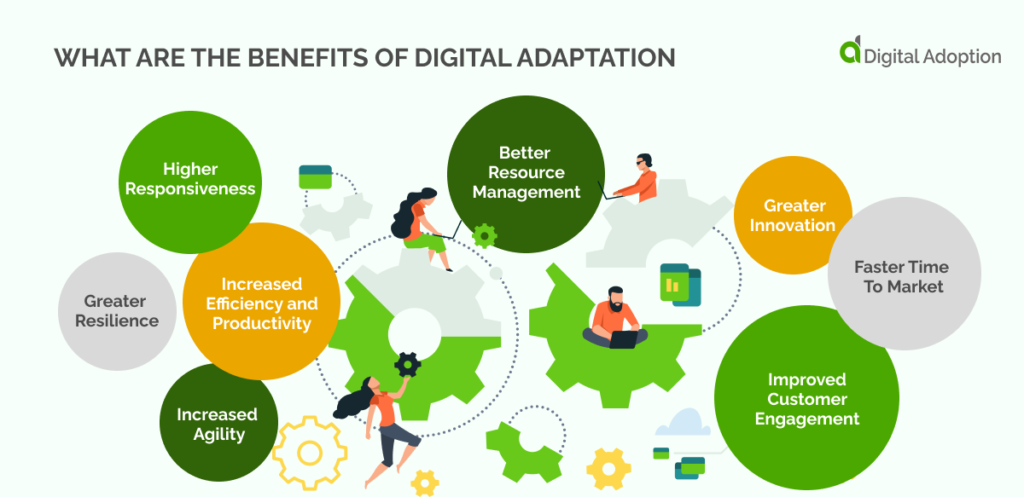
There are many advantages to digital adaptation.
- Increased efficiency and productivity: Digital technologies used by a digital team deliver gains in efficiency and productivity by quickening processes and streamlining operations.
- Better resource management: Resources are easier to manage more effectively through a digital adaptation strategy.
- Greater resilience: Companies that employ digital adaptation endure obstacles better and show greater longevity via digital initiatives. IT leaders are crucial to implementation.
- Increased agility: Digital transformation efforts promote fundamental changes, bolstering the ability to compete and thrive. Increasing modern technology spending is one method.
- Improved customer engagement: With digital adaptation, customer intimacy grows as the public use more digital products in their personal lives.
- Higher responsiveness: Tailoring technology within a digital culture to bespoke and changing needs increases the ability to respond quickly and effectively to market changes.
- Greater innovation: Successful digital transformation initiatives drive greater innovations through digital means. Just what forms this takes is down to specific company needs.
- Faster time to market: A business strategy with increased investment in digital transformation ensures products get to users quickly.
What Is A Digital Adaptation Strategy?
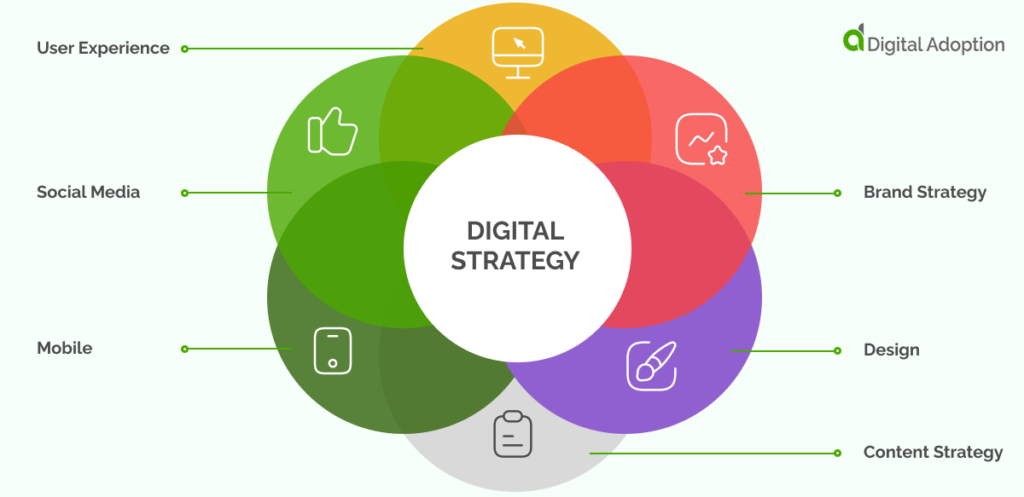
A digital adaptation strategy is simply a vision for change, prioritizing the need to adapt and innovate. Digital adaptation strategies require views from different viewpoints.
Creative departments view a digital adaptation strategy through digital marketing and user experience (UX). UX in this context is the notion that when customers meet their needs by discovering new items via utilizing search engines.
Management consultants see digital adaptation as an opportunity to change a business radically. A company repositions closer to new business models. Products and services can become aligned with new technologies. Reduction in overheads leads to increased profits.
Of these two viewpoints, both are correct. An effective digital adaptation strategy occurs when the two viewpoints combine through collaboration and liaison via business leaders.
Management consultants are necessary to improve internal processes. The creative department is needed to show customers the value of a business and its improved business practices in an appealing manner. But there is one unnamed piece to this puzzle.
From digital leaders to digital team members at every level, everyone contributes to fulfilling the vision of a digital adaptation strategy, allowing a company to become a global leader in its field.
The Value Of An Adaptive Approach
An adaptive approach ensures that the focus is always on the client or customer. The adaptive approach is essential to success, as feedback from the client helps measure effectiveness.
The client must drive how changes occur within this, ensuring client loyalty and optimizing user-analytic skills within a company. In the best-case scenario, the client is included in every decision, ensuring they are satisfied with the end product.
An adaptive approach will always ensure that the focus is on change management. There should always be constant changes within a strategy as time goes by, as these are essential to ensuring endpoint success.
Prioritization is a crucial benefit of adaptability. When change is at the core of a company’s decisions, prioritization becomes a must. Continuous feedback is another precious asset. Clients, customers, and team members are a significant measure of success.
How Does Digital Adaptation Intersect With Digital Transformation?
On the surface, much like companies Microsoft and Apple, digital transformation and digital adaptability seem very similar. However, much like this example of two companies producing hardware and software, the differences are vast.
When we look at any digital transformation, we see that it involves a time-limited plan. Conversely, digital adaptability requires a strategy rather than a plan. Digital adaptability needs ongoing review.
These two intersect because businesses can learn from their previous experiences of having created a digital transformation strategy in the past. The effect this had on team member attitudes and culture, resources required, challenges, triumphs can be recalled, along with the lessons learned. Lessons learned from the previous experience can be integrated into the digital adaptability strategy, increasing innovation and reducing dependence on legacy culture.
Why Is Digital Adaptation The Most Valuable Metric For Success?
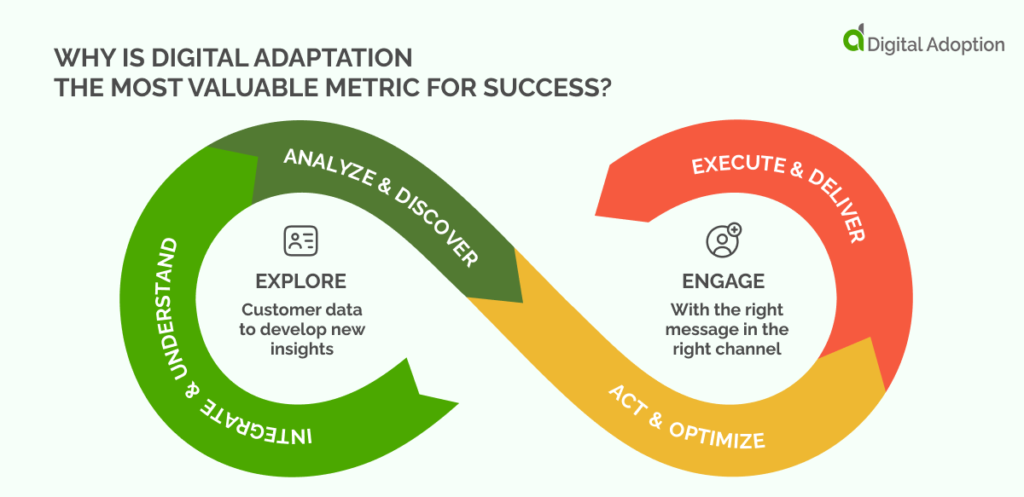
The benefit of using digital adaptability as a measure for success is that it leads to gains while being a measure. Digital adaptability is ever-changing, allowing reaction and review of goals and how to achieve them. This use of digital adaptation as a measure of success is an excellent example of the value and significance of integrating digital adaptability into every aspect of a business.
Workforce Change: Delivering New Employee Models
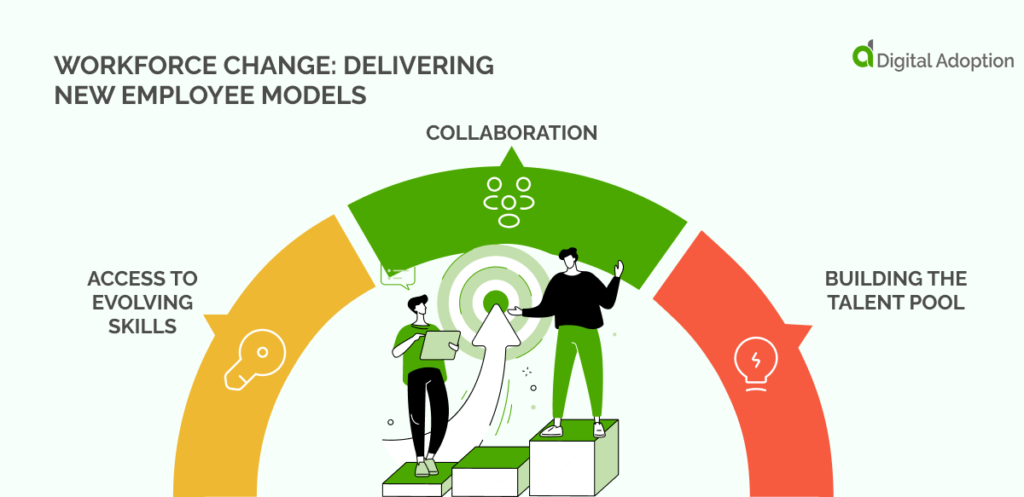
For a new business adaptation strategy to achieve its aims, team members must adjust and change. Supported team members maintain new cultures of openness toward an effective digital strategy.
Complete digital transformation exists within a high-performance culture. The utmost significance of the strategy is understood and appreciated by all team members of each department. Without support, any such strategy will fail, and the desired digital revolution will be short-lived.
Access To Evolving Skills
IT leaders and senior management must carefully select easy-to-use software. This new software allows team members to train in new skills. All team members should know whom to refer to ask questions about new forms of training and if they struggle with skills or feel undertrained. Team members can also be given face-to-face demonstrations in groups to introduce new technology.
Collaboration
Managers and business leaders need to nourish collaboration between vastly different departments via sharing information at all development stages within projects. Partnership promotes strategy values because team members are always aware of other aspects of development within their own company.
Implementing a company-wide intranet social media platform is one way to encourage collaboration via promoting each team member to embrace social media. Social media for internal communication can also create an awareness of essential skills, such as social media marketing.
Building The Talent Pool
A team that understands the values of a digital adaptability strategy and is empowered to practice these values is essential. A brand new team isn’t always needed, but some new team members may be helpful.
New team members at any level will quickly take on the culture and values of the current digital adaptation strategy as they enter the company. The benefit is for all team members as values are dispersed and discussed.
However, existing team members also need to feel included in decision-making to absorb and integrate new practices. All team members should have several opportunities to voice their views when constructing a new digital adaptability strategy.
Finally, senior management is at the forefront of a company culture change. Management is always aware of strategy values, and dialogue is kept open about views. If needed, a new management role, such as a Head of Digital Adaptability Strategy, can also be instated to coordinate a new digital strategy.
It may also be helpful to employ new team members skilled in change management to assist team members with the strategy’s changes. And one last action to consider is setting up an internal talent marketplace.
Five Ways To Achieve Total Digital Adaptation
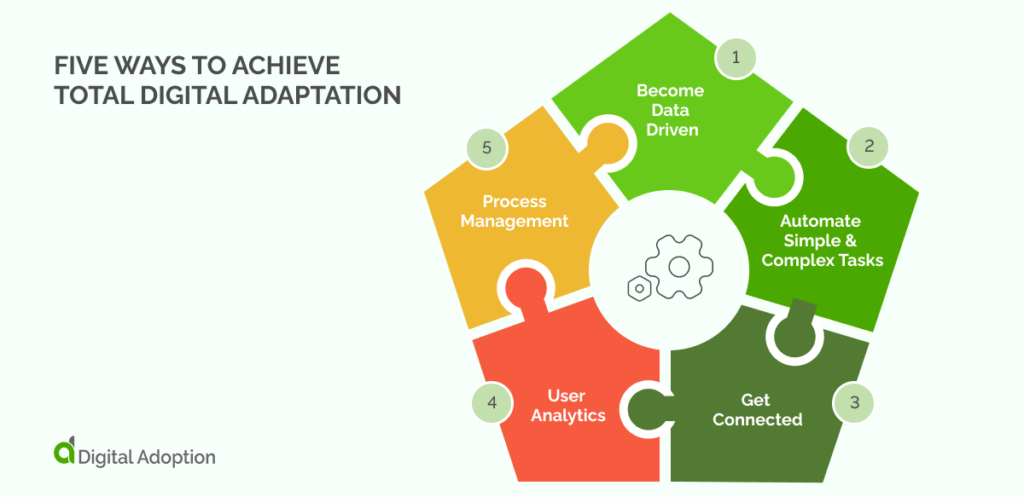
1. Become Data-Driven & Analytical
Data analytics and being data driven may seem dull as dishwater to some. It may seem like a paradox that they are essential to innovation, forming the core of a changing culture.
Analysis of data is of high significance within a digital adaptation strategy. Data needs to be collected to ensure the need for a digital adaptability strategy and how this should look.
Data must also be collected to ensure that the strategy facilitates more insights to minimize delays and reduce dated workflows. The process is ongoing, with the strategy reacting to all forms of digital disruption and other market changes.
2. Automate Simple & Complex Tasks
Digital adoption means accepting that every business now exists within a digital landscape. New digital means are therefore required.
As a result, business process automation tools such as artificial intelligence increasingly play a more prominent role in our everyday domestic tasks.
Think about how Spotify uses AI to predict music you might enjoy.
But AI can also play a prominent role in business, particularly for simple tasks. For example, internal processes such as scheduling tasks can be allocated to AI software to increase time spent by customer service team members, allowing them to dedicate more time to direct customer contact, improving the quality of customer experience.
Machine learning can help answer questions driven by what is likely to happen in the future and what the best decisions can be right now, which is particularly useful when predicting consumer behavior. Machine learning can also play a valuable role in more complex tasks, like driving decision support.
3. Get Connected
Social media can be an accessible form of digital technology for team members of every level and department to stay in touch in large organizations. Such use of technology promotes collaboration, leading to better practice of the values of the strategy within digital culture.
However, you can use social media and other digital communication methods to stay in touch with customers. Customer Experience (CX) is essential for tracking customer needs and how this relates to the strategy’s success.
The panel discussion can also effectively collect customer experience data in a more casual environment.
4. User Analytics
Parallels exist between team member attitudes and customer experiences of a new strategy. Both are at the heart of a successfully created digital adaptation.
Collecting data on customer experience allows data on the success of the customer-facing aspect of the strategy to ensure the effectiveness of future changes to digital operating models.
5. Process Management
At every stage, process management is key to the success of a new strategy.
Regularly taking audits and initiating discussion of how success is perceived at different points by different departments at all levels is essential.
Any changes to the strategy must then take place based on the feedback of team members, clients, and customers.
Keeping a positive change
A company can thrive with a competitive edge and comfortable market share using a business adaptability strategy through constant revaluation, risk-taking, and digital transformation efforts.
Each team member must have shared values regarding digital adaptation at every level. Employee experience is imperative. Otherwise, the benefits will not stick, and the business will become unsuccessful.
A responsibility matrix can also be highly useful in maintaining the values of a strategy. Team members at every level are empowered to carry out the strategy in a structured and meaningful way.
Implementing a digital adaptability strategy can be challenging as some team members may wrongly feel that they are already engaged in the best practice, leading to inefficient processes.
Team members can ignore best practices due to inefficient processes, such as toxic practices. But all team members need to be supported to understand that it is essential to apply techniques that follow a digital adaptability strategy. Traditional businesses avoid toxic practices and become future-proof.
Team leaders and CIOs also look to organize teams to benefit both the company and each team member. Effective employee onboarding tailored to each new and existing team member is a large part of the success of a new strategy.
All team members see that such a strategy benefits themselves and their colleagues’ level of pride and empowerment. The business thrives long into the future following a successful business adaptability strategy.

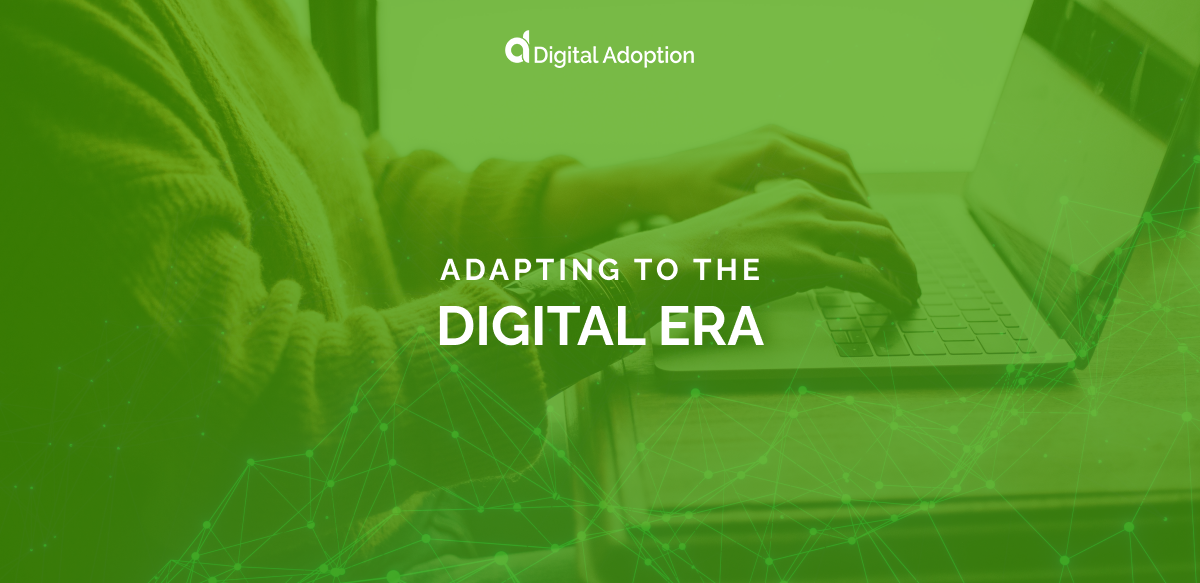



![18 Examples of AI in Finance [2025]](https://www.digital-adoption.com/wp-content/uploads/2025/06/18-Examples-of-AI-in-Finance-2025-300x146.jpg)
![14 Examples of AI in Manufacturing [2025]](https://www.digital-adoption.com/wp-content/uploads/2025/06/14-Examples-of-AI-in-Manufacturing-2025-300x146.jpg)
![29 Examples of AI in Education [2025]](https://www.digital-adoption.com/wp-content/uploads/2025/06/29-Examples-of-AI-in-Education-2025-300x146.jpg)
![15 Examples of AI in Retail [2025]](https://www.digital-adoption.com/wp-content/uploads/2025/06/15-Examples-of-AI-in-Retail-2025-300x146.jpg)


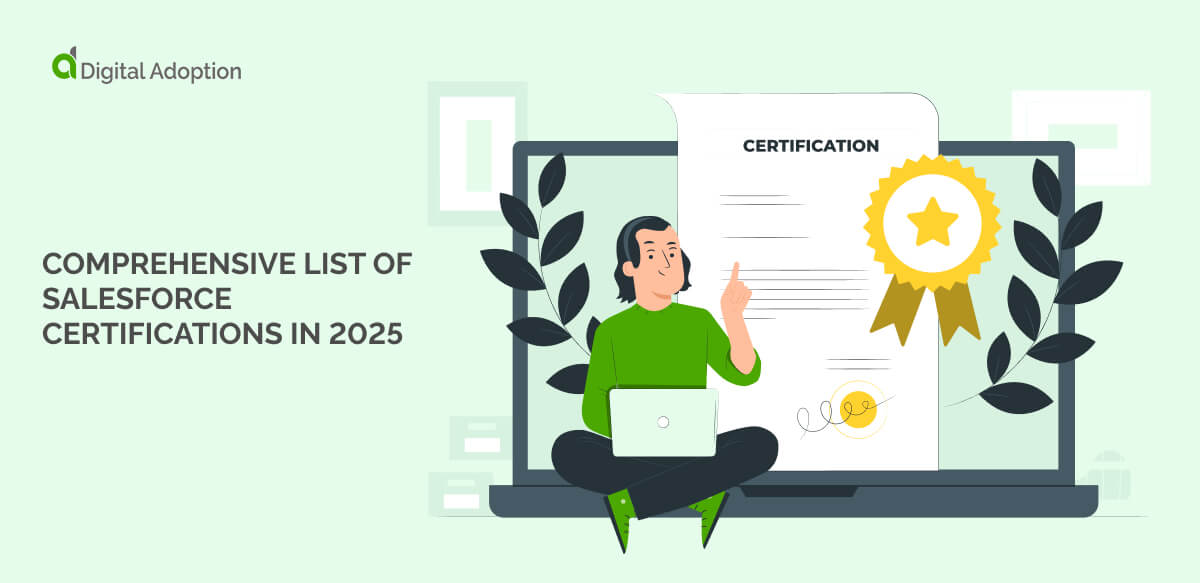
![18 Examples of AI in Finance [2025]](https://www.digital-adoption.com/wp-content/uploads/2025/06/18-Examples-of-AI-in-Finance-2025.jpg)
![14 Examples of AI in Manufacturing [2025]](https://www.digital-adoption.com/wp-content/uploads/2025/06/14-Examples-of-AI-in-Manufacturing-2025.jpg)